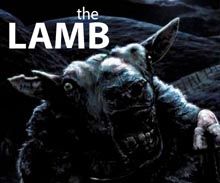The prologue of Sting (2024, directed by Kiah Roche-Turner) is a concise and entirely satisfying little short story in which a woman suffering from dementia hears alarming things from her air vents and calls an exterminator. When the exterminator arrives, he's pissed to discover another exterminator's truck parked in front of the woman's building. He reads the woman the riot act when she answers the door. Then he gets to work, only to discover that he's not at all prepared for what he finds in her vents. The end of the story has a wicked whip of the tale. It reminds me a bit of short stories by Robert Bloch or John Collier or Ray Bradbury, or of E. C. Comics (who tended to loot their stories from writers like Bloch or Collier or Bradbury). It's a poisoned bon bon, a cookie full of cyanide. A tasty warm-up act, if you will. The rest of Sting isn't up to the level of its prologue, alas, but the prologue provides enough good will to carry an audience through the film. Or, at least, it carried me through to the end.
The story proper begins weeks earlier, when a small meteorite comes through the window of the apartment building where the old woman of the prologue lives with her sister, the landlord. The meteor is found by Charlotte, a girl who uses the air ducts to travel through the building. It contains a spider-like creature and Charlotte takes it as a pet. She names it "Sting" after Bilbo's short sword in The Hobbit. feeding it insects and whatnot. At first. Then the creature grows. And grows. Soon it's chowing down on the inhabitants of Charlotte's building, starting with pets, then moving up to humans. Charlotte enlists her overworked step-dad, Ethan, to help her stop Sting, but neither of them reckon with how big the creature is getting. And it's smart. While Charlotte is tending to her infant brother, Sting captures her parents and it's up to her to rescue them. But Sting lays traps for her, too...
Some viewers are liable to see Sting as a cartoon. It's a fair cop, but I think that's a deliberate effect. The way the sets are lit, the way the camera is tilted, the lenses the filmmakers have chosen, the way the characters are broadly caricatured, the way it gleefully embraces its creature feature premise, all of these things suggest filmmakers who aren't interested in naturalism. This is a film that is ostentatiously gloomy, a bit like a kids' movie set in Amityville. If I was to compare it to other filmmakers, I would call this Raimi-esque. Visually, it resembles Evil Dead Rise, with which it shares the same apartment setting. For all I know, it was filmed on the same sets, given that both films were shot in Australia. So, yeah. It's a cartoon. That's not a criticism, per se; it's just a description. As a cartoon, it's not bad. Moreover, it winks at the audience and underlines its cartoonishness. Its lead characters are making a comic book, after all.
Me? I admire the way the first act of the film uses Charlotte's step-dad, Ethan, as a guide through the building in his role as the super. He introduces the audience not only to the various characters, but also to the various plot points to come in a way that's natural to the internal logic of the film while being transparent to an alert audience. His tour of the building underlines just how many tasty things there are to eat in the building: a pet dog, a parrot, the mean old slumlord, a baby. We see a guy training his fish with an ultraviolet light, and we know that that might come in handy later, or that the dude is the film's expert on weird animals. We meet the woman from the prologue, who is Ethan's mother-in-law. We wind up in the basement where he fumbles with a faulty trash compactor that might as well have "Chekhov's Gun" written in a big neon sign on the side. Sure enough, the trash compactor figures in the film's climax. This gave me a good laugh and I'm pretty sure it's meant to. It is possible for a viewer to bail on the movie at the thirty-five minute mark and imagine a better movie than what is provided by the second and third acts, though. They've given the audience the entire scheme of the movie up front after all, so there aren't really any more surprises after that. I mean, it's not bad, but there is an element of marking time between shots of the monster and gory kill scenes.
The monster is pretty good, but it's not a category killer the way Shelob was in The Lord of the Rings. Sting is a sleek black thing modeled on a black widow, but with different markings. It has a personality, especially in the early going as it builds a relationship with Charlotte. It even communicates with Charlotte with a vocalized trill. The movie really sells Sting by using practical effects to bring her to life. It doesn't have the digital perfection of CGI, nor the uncanny valley effect that goes with it. She's a puppet that bounces real light on a real set surrounded by real actors. The film leans into practical effects for its gore, too, of which there is plenty. The filmmakers rely maybe too much on the idea that arachnophobia alone will be enough to terrify the audience, but at least they don't disappoint anyone who suffers from that irrational fear. The spider is good enough. The mayhem is good enough. The effects are icky enough. Like many contemporary horror movies, this is allusory, which should be self-evident from the name of its heroine. The setting, with its emphasis on air ducts, suggests that the filmmakers are taking their cues from Alien and Aliens, and the film liberally quotes from other monster movies, but, well, hundreds of films have beaten that path through the genre. So who cares, right?
Where this film really stumbles is in the nuclear family über alles lesson it intends to impart as the moral instruction imposed on Charlotte. Charlotte is a rebellious, disaffected kid at the outset and there's no real reason for it, apart from the absence of her biological father. Ethan seems a pretty solid guy, solid enough for her to collaborate on a comic book together. He's very much involved with her as a parent. So her disaffection seems manufactured for the movie. Moreover, Charlotte seems otherwise to be a neat kid, who has creative drive and scientific curiosity of the sort that gets her into trouble and will get her into college, but there's nothing malicious about her. The film's path from innocence to experience is more an Outward Bound program than a dark night of the soul, one that steers its heroine toward a more socially acceptable role in her family. There's a regressive streak here which clashes with the story's keen interest in turning Charlotte into a tween version of Ellen Ripley. This has incoherent politics woven throughout.
Mind you, I doubt the filmmakers care about any of this. This is a basic monster movie and it uses its available characters to provide monster movie motivation to its chosen hero. In this regard, the reference to The Hobbit is apt. Charlotte is a character who must find her inner hero in the crucible of this film's plot, even if the early going finds her in a deal with the devil. At its most basic level, Sting understands the shape of a monster movie. What it lacks is psychological complexity, but that's not too much of a failing for a film that's aiming at pure entertainment. It does make for a slight experience. The actors do what they can. Alyla Brown does a fine job as Charlotte, and Ryan Corr is essentially likeable as Ethan. Most of the other actors outside Charlotte's immediate family group are playing caricatures for the most part, with costume and make-up doing some of the lifting. As a monster movie, it codes various characters as chum, which is fine. That's a feature of the genre. Adhering to the genre is very much this film's modus operandi, up to and including its whip of the tail at the end.
While this film doesn't provide much in the way of novelty, it's a professional piece of work and unpretentious to boot. It knows what it is and doesn't get off in the weeds attempting any grand statements or statements about trauma or whatever other bullshit threads through more rarified horror movies these days. It's not that ambitious. It delivers on the promises it makes. It just doesn't promise too much. Maybe that's for the best. Maybe that's enough.

This blog is supported on Patreon by wonderful subscribers. If you like what I do, please consider pledging your own support. It means the world to me.





















No comments:
Post a Comment